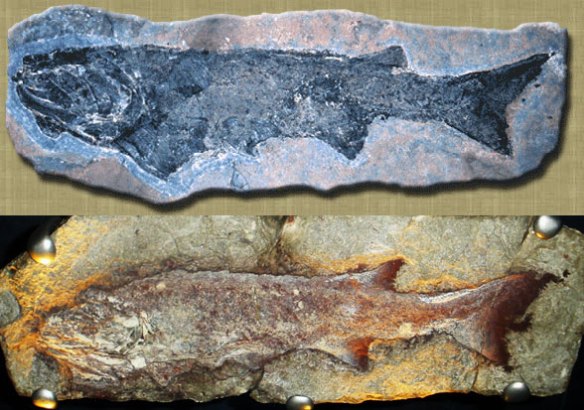The most recent changes
to the large reptile tree (LRT, 1583 taxa, subset Fig. 1) resolve earlier problems and place two spiny sharks (clade: Acanthodii, Fig. 1) at the base of the newly expanded pre-lobefin clade, all arising from catfish + placoderms, some of which also have spiny pectoral fins.

Figure 1. Classic reconstruction of Cladoselache, a shark-like taxon. Note the robust pectoral fin skeleton. A Silurian sister is the genesis for the spiny sharks, catfish and placoderms.
These in turn
arise from taxa like Cladoselache (Fig. 1), which had strongly supported pectoral fins along with robust anterior spines on the two dorsal fins, homologs of dorsal spines on spiny sharks.

Figure 2. Updated subset of the LRT focusing on basal vertebrates (fish). Arrow points to Hybodus. This tree does not agree with previous fish tree topologies.
The tiny size of the basal acanthodian, Brachyacanthus,
(Fig. 3) documents phylogenetic miniaturization at the genesis of a new major clade. If large eyes, a high forehead and a short rostrum indicate ‘cuteness’ and neotony, then Brachyacanthus is an early example of this. Cladoselache (Fig. 1) has two out of three of these traits.
According to Wikipedia
“Acanthodii or acanthodians (sometimes called spiny sharks) is a paraphyletic class of teleostomefish, sharing features with both bony fish and cartilaginous fish. In form they resembled sharks, but their epidermis was covered with tiny rhomboid platelets like the scales of holosteans (gars, bowfins). They represent several independent phylogenetic branches of fishes leading to the still extant Chondrichthyes.” In the LRT spiny sharks don’t lead to sharks, rays and chimaera, but diverge away from them.

Figure 3. The placoderm/catfish to spiny shark/lobe fin transition. We need more Silurian taxa, but here’s how the LRT recovers it. Brachyacanthus, once again, documents phylogenetic miniaturization at the genesis of new major clades.
So, what is it about the spine fin
that made it a key trait?

Figure 4. Cheirolepis fossils. Both have a spiny pectoral fin leading edge.
On the ray fin side of the cladogram
basal taxa include Pholidophorus (Fig. 5) and Coccocephalichthys (Fig. 6). This clade embraced open water speedy swimming and predation as their niche from the start. The extant tuna (Thunnus) is an extant relative of these two. Later taxa, like the frogfish (Antennarius) and sea robin (Prionotus), reverted to bottom-dwelling.

Figure 5. Pholidophorus fossil ghosted to highlight the fins and eyes.
By contrast, lobefins and their predecessors
appear to have preferred a slower swimming, bottom-dwelling lifestyle. That’s how they readily transitioned into shallow waters, swampy waters, swampy land and dry land in that order.

Figure 6. Coccocephalichthys (formerly Coccocephalus) is a Late Carboniferous transitional taxon between Devonian Strunius and Cretaceous Saurichthys.
Even so,
some highly derived lobefins learned how to climb trees, fly, and even speed through open waters, with or without fins (Homo, Orcinus, Pavo).
